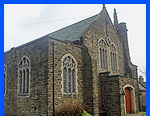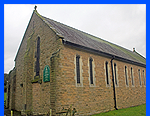Background
In the early 1920s there were around 200 Catholics living in Earby but no church, people had the choice of attending Sunday Mass in one of the local halls, (licensed for dancing at other times) or walking or cycling to the Catholic chapel at Broughton Hall.Confessions and religious instruction for children and would-be converts were held in private homes.
The Plan
By 1925 parishioners were united in their wish to have their own church – that was to be named after the patron saint of the parish, St Patrick.It was estimated that a new church would cost around £2,500 and with most Catholics in the town being working class with little money to spare it was obvious that they had to involve the local community if they were to have any chance of achieving their dream. So it was, that at Easter 1925, the Rt. Rev. Joseph Robert, Bishop of Leeds, adding his support to a public appeal, “St Patrick's Bricks”.
Under the appeal, 50,000 “bricks” went on sale at one shilling each– every parishioner urged to buy at least one themselves as well as persuading friends and neighbours to contribute. Bricks were issued in sheets –with a hod of bricks (10 bricks) – costing 10s; half a hod (10 half bricks) –costing 5s ;and a quarter hod (10 bricketts) – costing 2s and 6d.
The Outcome
The appeal was a great success and the foundation stone for the new church was laid on 9th April 1928 by the Bishop and officially opened for worship in October of that year.
Architect Charles Simpson, who had drawn up the plans for the rock-faced sandstone building with its stone coped gables and Welsh slate roof was among the congregation.
First Civic Service
The first civic service at the Northolme church took place on 6th June 1953 and was one of a number of religious services across the country celebrating the coronation of the new monarch, Queen Elizabeth II. A parade led by the local constabulary and Earby Brass Band, Coun. John O'Toole, chairman of Earby UDC and other official dignitaries marched to St Patrick's for a divine service. Fr O'Grady,priest-in-charge at the time, celebrated Mass and during his sermon, he told the congregation what a true example of family life the new Queen was and how great her sacrifice by dedicating her life for the good of all her people.Special booklets had been printed out to ensure that all the non-Catholics in the congregation could follow the Order of the Mass and a special blessing calling on God's blessing on the Queen was read out in line with instructions from the Cardinal Archbishop of Westminster.
Golden Anniversary
A celebration mass, to mark the church's 50th anniversary took place in October 1978. Led by parish priest, Fr C Roddy, guests included one of his predecessors, Fr P. Roche, as well as some long-standing members of the congregation who had been involved in the original fund-raising appeal.
Mr and Mrs Henry Tempest, of Broughton Hall, also attended as did representatives fromother churches in the town.
After the Mass a reception was held at the Linden Road Centre. Miss Sarah Gleeson, the oldest member of the church was invited to make the first cut on a celebration cake made especially for the event.
Present Day
For much of its history, St Patrick's Church was associated withal Saints' Chapel, Broughton, but in 2012 Bishop Arthur Roche outlined plans to reduce the existing three parishes in the Skipton and West Craven area to two. Under the changes, which were adopted after consultation, St Patrick’s Church was formally linked with St Joseph's Church to become one parish with one parish priest, initially Fr Simon Winn and in 2015, Canon Kevin Firth The future vision is that there will be a real alliance between the two congregations which will further enhance the vision of those pioneers back in 1925.
Please take a look at the copy of the St Patrick's Brick Appeal leaflet.
Archive photograph of May Queen c 1953















